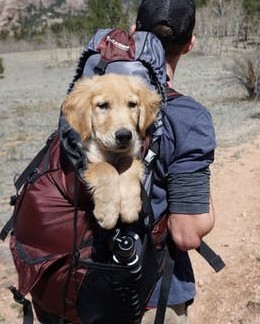We all love our pets and would never intentionally do anything to harm them in any way, right? What if I were to tell you that a great many people are unintentionally causing man’s best friend considerable suffering?
Unfortunately, that’s the case and you probably see it every day.
Living in the deep south of the United States is all about being outdoors enjoying the sun and fun. That’s why so many people move here, to enjoy the warm, sunny weather.
We don our wide-brimmed hats, sunglasses, slather ourselves down in sunscreen, grab a towel, a cooler full of drinks, slip into sandals, and we’re out the door to enjoy the day.
Our canine amigos aren’t quite so lucky.
Imagine heading out to enjoy a hot summer day but without a wide-brimmed hat, no sunglasses, no cooler, no sunscreen, no towel to lay on, and no sandals PLUS you’re dressed in a fur coat!
While you’re imagining, remember as a pet, you have no choice in the matter whatsoever and depending on your human friend to look out for your wellbeing. Gulp!
Sound like fun?
Look at the chart below and consider what it’s like for your head to be no more than a foot off the ground and standing or walking on hot pavement or even dry sandy beach. A bit uncomfortable, eh? Yeah. It’s hot down there. That’s what your dog must contend with.
Ask any motorcycle rider that takes a road trip in Florida during the summer. It’s like cruising behind a Jumbo Jet taking off from a runway. Toasty!
Every day, during the hottest part of the day, you can see dog owners taking their fur buddy for a walk or a jog, giving them no alternative but to walk on concrete sidewalks, streets, and around the high tide line on the beach where the sand can be blistering hot…never considering what their pet my be experiencing.
Let’s be clear. No one is saying that anyone is intentionally mistreating their pet(s).
But there are, apparently, a lot of pet owners who are simply not aware of the extreme temperatures surfaces can reach in full sun or perhaps they’re unaware of the vulnerability of paws to those high temperatures.
The whole purpose of this article is to raise awareness, in the kindest, friendliest way, regarding the issue.
So what can you do to help?
- Share the Simple Surface Test (SST) with friends
- Post a copy of the SST in high traffic areas
- Ask pet owners you encounter if they know about the SST
- Ask your friends if they would help increase awareness
- Share this article
- Share your ideas on getting the word out in the comments section below
A frustrating encounter
Recently, on a typical 95°F afternoon, I encountered a gentleman coming out of a building supply store with an older, terrier-sized dog on a leash following faithfully behind. The dog was apparently enjoying the trip and happy to be with his human pal.
I was following behind the two and just the gentleman and his dog reached the asphalt, they met an acquaintance coming from the opposite direction towards the store. They both paused to shake hands and exchange pleasantries while the dog dutifully stopped alongside.
I noticed the dog didn’t remain still for very long at all. In fact, he was fidgeting around moving side to side and looking up at his owner, around his immediate area, like he was anxious and looking around for something.
He laughed and said, “Nah, he’s got his got his shoes on.” He apparently had no idea the dog was suffering!
In my politest voice, I said, “Your shoes might keep your feet from burning but your dog’s foot pads are clearly not enough to protect against this asphalt.”
I received an uncomprehending dear-in-the-headlights stare and without saying another word, the gentleman simply pulled on the leash, forcing the do dog back onto the pavement, and continued onward toward his parked vehicle.
That poor terrier looked like a Tennessee Walking Horse high stepping across the hot asphalt. Hopefully, his automobile’s seats weren’t covered in black vinyl too.
Noticing the dog moving around, the gentleman said his goodbyes and continued his trek toward his vehicle talking to the dog as he moved ahead.
They came to a curbed, raised patch of ground covered in mulch and the dog determinedly pulled against the leash, climbing the curb onto the mulch, then sat down.
The gentleman gave a little tug on the leash, asking, “What are you stopping here for, bud, the car is over this way.” He gave the leash a gentle tug.
Given the gentleman’s lack of awareness of the obvious and pretty sure the dog wasn’t going to answer, I spoke up and said, “He’s just trying to get off the hot pavement because his feet were probably burning!”

I felt so bad for the terrier being forced to endure that experience and sad that his owner was completely clueless regarding the dog’s discomfort.
I’m sure, like many folks, this man apparently didn’t understand how hot various surfaces can become when exposed to direct sunlight. Even a pleasant 77°F day with a light breeze blowing can produce surface temps upwards of 125°F! That’s anywhere, not just Florida.
Now imagine what those same surface temps would be if it’s a bright sunny day with little or no breeze. We know that as a typical 95°F summer day here in Florida. Surface temps can exceed 138°F on concrete, and 130°F at the high tide level on the beach or 151°F on asphalt.
That’s the territory of 2nd- and 3rd-degree burns on bare skin.
And you thought Fido was just excited to be going on a walk with you, right? Maybe not entirely.
Keep in mind: The darker the surface, the hotter the temperature.
That has to do with the surface’s albedo rating if you want to get all technical about it or simply, how well a surface reflects solar energy.
Canine foot pads are awfully tough. They can withstand considerable abrasion, but heat is a different matter. Those tough little pads will burn just like your feet when exposed to high surface temperatures.
Cold is an entirely different matter too, given a dog’s ability to warm its feet due to specialized blood circulation in the footpad, but that’s a subject for another article.
That specialized circulation also means walking on hot surfaces will rapidly increase a dog’s body temperature from the normal 101 – 102 range to, at the very least, uncomfortable levels.
Prolonged exposure increases the possibility of heatstroke. It can and does happen.

Can you stand or lay on anything where the temperature is at 150°F for more than two seconds without receiving some urgent messages from your nerve endings?
Things start getting uncomfortable PDQ. Temperatures in this range can cause 2nd and 3rd-degree burns with prolonged exposure. Your pet might last a second or two longer than you but, trust me, they are at the very least, extremely uncomfortable.
Quicker than you can say, “Poor baby!” your fur pal will likely suffer a painful burn.
Some might say, “Yeah, but wild animals have been around for thousands of years, living outdoors, walking around in the heat and cold, and seem to be doing alright by themselves. Besides that, they sweat through their paws to keep ‘em cool.”
That’s quite true, but a few things have changed in those thousands of years. Wild animals didn’t have to contend with our paved surfaces, nor being tied to a leash and forced to go where they wouldn’t go if it were left to them to decide. Leash trained isn’t the same as wild and free.
Yes, they do sweat through their paws to help cool off. You do too. Go stand on that hot pavement and tell me how that’s working out for ya?
Consider this.
Where do you find an unleashed pet in the heat of the day? In the shade, usually asleep, right? But not humans, noooo. We’re out there in the glaring sun jogging, tanning, hiking, etc…and we’re supposed to be the intelligent species! ![]()
When in doubt, check it out. Use the SST
It’s all about awareness

Are we saying never take our pet on a walk or jog ever again? No, of course not. Dogs love going with you on an outing. Some cats too. Just be sure to consider your pet’s needs too when preparing to go out and about.
Here are some steps you can take to prevent your pet from suffering any discomfort or worse.
- The logical solution would be not to take an animal at all as long as surfaces fail the Simple Surface Test (SST) but if they must go, provide them with some protection
- When out and about with your pet, let them walk in the grass or soil rather than the pavement
- Be aware that the dry sand on the beach is scalding hot. Your pet will need help getting across the dry sand to avoid discomfort
- Use a pet stroller for your pup, ferret, rabbit, aardvark, kitty, whatever…
- Walks taken on too hot or too cold surfaces require some form of protection. Remember. It only takes 60 on a 125º F surface to cause a painful burn.
Let’s talk protection
“Protection? What kind of protection?”
Paw protectors come to mind right away. They are super affordable pet care items worth considering.
When would you ever need them? Well, you know, there are times when there’s no choice in the matter. Your pet must come along with you whether on foot or for an automobile ride regardless of environmental conditions. Stuff happens. What if your transportation breaks down, you”re stranded, and all of you are just going to have to hoof it?
No sweat for you. Well, maybe a lot of sweat but no real threat. You’ve got shoes, a hat, maybe an umbrella, a bottle of water or two…you do have those with you don’t you? But what does your pet have? Nutin’? Yep. Providing for them is up to you as well. Smitty the kitty is part of your crew too. They are in about as much trouble as you had you forgot your emergency road kit.
Roadside Emergency Pet Bag
- Water, 4 ea., 23 oz bottles
- Paw protection, preferably dog boots
- Snacks
- Leash
- Collapsible water bowl
- Space blanket
- 50 ft 550 paracord or nylon string. Use to hang blanket if shade required.
Packin’ da pup
Options: You can carry the animal. Small dogs, cats, or gerbils are portable enough. You could keep a backpack in the car for them, but your Great Dane or Mastiff might be a tight fit.
If you regularly take your dog on car trips, you need to invest in a pair of boots because most big dog carrying sized wagons don’t fit in the trunk too well, do they?
“Boots? For a dog? You must be kidding!”
Nope. As pet owners it’s our obligation to do what we can to protect our pets and that naturally includes paw protection from hot surfaces. The cat you can probably just carry, push come to shove.
Smaller breeds like Yorkies, Chihuahua, Shih Tzu, and the like could fit in an umbrella stroller to keep them off the pavement.
Big dogs are another matter. They need footwear and there’s a wide selection of reasonably priced canine boots available on sites like Chewy.com, Amazon (of course), Petco.com, etc.
You can get an emergency pair to keep in the car for around $15.00. More durable, long term use dog boots can run as high a $100 or more but right now we’re talking emergency boot, not work boots.
I’ll leave you with this:
- Never, EVER leave your pet unattended in your automobile
- Not on a nice spring day with the windows down just a bit. You’re inviting car theft, dog theft, and an introduction to the local constabulary. They do fine offenders.
- Not even with the engine running and the AC on. What if poochie-poo manages to:
- Move the transmission shifter from park into drive?
- Moves the shifter from neutral into “outta there” and into the building where you are?
- Sits on the gas pedal and reves the engine up ‘till she blows? Ewe expensive!
- Lays on the horn and stays on the horn? Awkward!
- Just not worth the risk, is it?
- If you see a pet, or worse, a child unattended in an automobile, get someone involved immediately. The time they have left before incurring serious injury or death could be measured in minutes! Especially in summer.
- If you see or know of someone exposing their pet to temperature extremes, tell them about this article and suggest they read it. Print out a copy of the SST to hand out to folks or post on local bulletin boards in public places as a reminder






Oh thank you for writing this article. I actually didn’t realize that the hot pavements can injure our pets! I and my cousin own two cute Golden Retriever pups. We sometimes let them walk outside across pavements. Since dry season, the temperature in the city start to rise quite high. We plan to buy a dog backpack to carry and protect them from heat. Thanks for the reminder
Absolutely and thank you for the comment. Please share the info with friends. It’s just a matter of making people aware of the issue.
I’m so glad you brought this to my attention. I never would have thought about it this way. But it does make sense. I know how much i hate just taking my sandals off on the beach to get in the water. that trip from the towel to the water is usually quick with a little high stepping along the way. We just recently got a puppy. He’s growing so fast. At six months now he already stands almost as tall as myself. But He’s not one to leave things on. any tips you could recommend for someone who’s pal is to big to carry. but won’t leave the boots on to protect himself? Any advice is appreciated. Thanks again for the amazing article.
I have read a lot about boots that have an over the shoulder strap that attaches to the boots. It’s designed to keep the boots from slipping off but I don’t think that would do much for one that chews at the straps. Maybe you could train him over a period of time to wear the boots and keep them on. Where is Ceaser the Dog Whisperer when you need him? lol
lol right. Definitely going to check these out. Rookie thanks you! (that’s our six month old Siberian husky/golden retriever). He’s been a handful but i didn’t know they had over the shoulder straps. These will most definitely help keep them on him. as for chewing at the straps. it took a while for him to get used to his harness. but he no longer scratches at it. (after having to replace it twice) so perhaps its something he’ll get used to. Thanks again!!!
please do let me know how that works out for you.
This is such a FANTASTIC article about paw protection for dogs and a whole lot more. This was a REAL eye opener for me. Thank you so much for this amazing information. I have never ever thought about how hot the concrete or asphalt is for my dog but I will absolutely think about it every time we go out now. Like many people I just assumed that their tough pads would protect them from the hot but it makes sense that like our human “summer feet” we can take lots of rocks and abrasive surfaces once we build up a callous but hot is still hot and if it would hurt my bare feet it will probably hurt my dog’s feet too. I am going to share this information with every dog owner I know because I feel it is very important, thanks for sharing.
Thank you for the nice comments. Like you, I had never really thought about it until I saw that one dog had to endure that day. I started researching and found out just how vulnerable our fur friends were. I’ve started asking shop owners in St. Augustine to have water bowls out for pets at their entrance and it’s starting to catch on. A few have expressed an interest in carrying the boots as well.
Thanks for helping spread the word. I think we can make a difference just by sharing the info with friends and them doing the same.
Thank you for writing this article. These days, I do not bring my dog out when the temperature is too hot. I remembered once I bring my dog out when the temperature was very high when my dogs walk on the concrete floor, he kept jumping until I let him walk on the grass.
I have seen many poor dogs walking on hot pavement. Many dog owners are not aware that their dogs are suffering.
I will share the SST test with my friends who have dogs.
Thank you.
Awesome! Thanks for sharing with your friends. If they’ll do the same with people they know, we’ll get the word out to more and more pet owners. I’m having some plastic cards printed with the SST on them to hand out to pet owners on the beaches around here. Also laminating some posters to place at beach entrances and some of the stores in St. Augustine, FL.